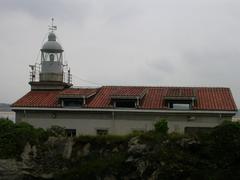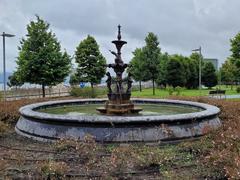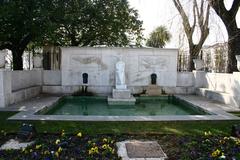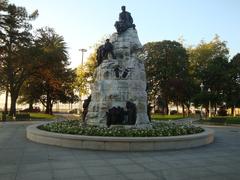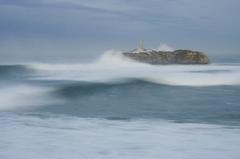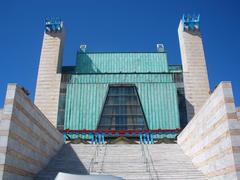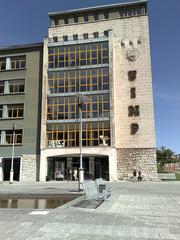Comprehensive Guide to Visiting Calle de la Familia Real, Santander, Spain
Date: 17/07/2024
Introduction
Calle de la Familia Real in Santander, Spain, is a street rich in history and cultural significance. Originally known as Calle Mayor, its roots date back to the medieval period when it served as a central artery for trade and commerce. Over the centuries, this street has evolved into a vibrant hub, symbolizing Santander’s close ties with the Spanish monarchy and its architectural heritage. In the 18th century, King Charles III granted Santander city status, leading to the renaming of the street to Calle de la Familia Real. This transformation marked the beginning of its association with the Spanish royal family and its significant role in the city’s development (Santander Tourism).
The street’s architectural landscape boasts neoclassical and eclectic styles, with landmarks such as the Palacio de la Magdalena, a royal palace built between 1908 and 1912, serving as a testament to its historical importance. Despite the devastating fire of 1941, which destroyed much of the historic center, including significant portions of Calle de la Familia Real, the street was meticulously reconstructed to preserve its historical character while incorporating modern urban planning principles (Centro Botín).
Today, Calle de la Familia Real is not only a historical landmark but also a cultural and economic hub. It is home to important cultural institutions like the Centro Botín and hosts numerous festivals and events, such as the Semana Grande, further enhancing its appeal to both locals and tourists. The street remains a bustling commercial district, contributing significantly to Santander’s economic growth and offering a unique blend of history, culture, and modern attractions.
Table of Contents
Historical Background
Origins and Early History
Calle de la Familia Real, originally known as Calle Mayor, has roots dating back to the medieval period. The street emerged as a central artery for trade and commerce during the 12th century when Santander began to flourish as a significant port city on the Bay of Biscay.
The Royal Connection
In the 18th century, King Charles III of Spain recognized Santander’s growing importance and granted it city status in 1755. This royal endorsement led to the renaming of Calle Mayor to Calle de la Familia Real, symbolizing the city’s close ties with the Spanish monarchy.
Architectural Evolution
The architectural landscape of Calle de la Familia Real evolved significantly over the centuries. During the 19th century, the street became a showcase for neoclassical and eclectic styles, with grand buildings lining its length. Notable structures include the Palacio de la Magdalena, a royal palace built between 1908 and 1912, serving as a summer residence for the Spanish royal family (Santander Tourism).
The 1941 Fire and Reconstruction
A pivotal event in the history of Calle de la Familia Real was the devastating fire of 1941, which destroyed much of the historic center, including significant portions of the street. Reconstruction efforts, led by architect Javier González de Riancho, aimed to preserve the historical character while incorporating modern urban planning principles.
Cultural Significance
Calle de la Familia Real has long been a cultural hub in Santander. The street is home to several important cultural institutions, including the Centro Botín, a modern art center designed by Renzo Piano, opened in 2017 (Centro Botín). The street also hosts numerous festivals and events, such as the Semana Grande, a summer festival featuring parades, concerts, and traditional Basque sports.
Economic Impact
Historically, Calle de la Familia Real served as a marketplace for merchants and traders. Today, it remains a bustling commercial district lined with shops, boutiques, cafes, and restaurants, contributing significantly to Santander’s economic growth.
Preservation and Conservation Efforts
Preserving the historical integrity of Calle de la Familia Real has been a priority for the city. One notable example is the restoration of the Mercado del Este, a historic market building that underwent extensive restoration in the early 2000s (Mercado del Este).
Visitor Information
Visiting Hours and Tickets
Calle de la Familia Real is accessible 24/7. However, specific attractions like the Centro Botín and Mercado del Este have their own opening hours and may require tickets for entry. Check their official websites for the most up-to-date information.
Travel Tips
- Getting There: The street is easily accessible by public transportation. Santander’s bus and train stations are within walking distance.
- Nearby Attractions: Don’t miss the Santander Cathedral and the Maritime Museum, both located nearby.
- Accessibility: The street is wheelchair accessible, with ramps and smooth pavements.
Conclusion
Calle de la Familia Real remains a vital and dynamic part of Santander. Its rich history, cultural institutions, and vibrant atmosphere make it a must-visit destination. From its medieval origins to its modern-day relevance, the street embodies the spirit and resilience of Santander.
FAQ
- What are the opening hours of Calle de la Familia Real? Calle de la Familia Real is accessible 24/7. Specific attractions have their own opening hours.
- Is there an entry fee for Calle de la Familia Real? There is no entry fee for the street itself, but some attractions may require tickets.
- What is the best time to visit? The street is lively year-round, but visiting during festivals like Semana Grande offers a unique experience.
Call to Action
For more updates and travel tips, follow us on social media or download our mobile app Audiala. Check out our other related posts for more exciting destinations in Santander.
References
- Santander Tourism, 2023, https://www.santander.es
- Centro Botín, 2023, https://www.centrobotin.org
- Mercado del Este, 2023, https://www.mercadodeleste.com
- Palacio de la Magdalena, 2023, https://www.palaciomagdalena.com
- Hotel Real, 2023, https://www.hotelreal.es
- Silken Coliseum Hotel, 2023, https://www.hoteles-silken.com/en/hotel-coliseum-santander/
- Hostel Santander, 2023, https://www.hostelsantander.com
- La Bombi, 2023, https://www.labombi.com
- Casa Lita, 2023, https://www.casalita.com
- El Machi, 2023, https://www.elmachi.com
- Mercado de la Esperanza, 2023, https://www.mercadodelaesperanza.com
- El Corte Inglés, 2023, https://www.elcorteingles.es
- La Casona, 2023, https://www.lacasona.com
- Hospital Universitario Marqués de Valdecilla, 2023, https://www.humv.es
